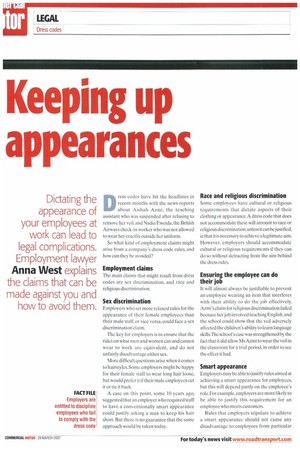Keeping up appearances
Page 36

Page 37

If you've noticed an error in this article please click here to report it so we can fix it.
Dictating the appearance of your employees at work can lead to legal complications.
Employment lawyer Anna West explains the claims that can be made against you and how to avoid them.
Dress codes have hit the headlines in recent months with the news reports about Aishah Azmi, the teaching assistant who was suspended after refusing to remove her veil, and Nadia Eweida, the British Airways check-in worker who was not allowed to wear her crucifix outside her uniform.
So what kind of employment claims might arise from a company's dress code rules, and how can they be avoided?
Employment claims
The main claims that might result from dress codes are sex discrimination, and race and religious discrimination.
Sex discrimination
Employers who set more relaxed rules for the appearance of their female employees than their male staff, or vice versa, could face a sex discrimination claim.
The key for employers is to ensure that the rules on what men and women can and cannot wear to work are equivalent, and do not unfairly disadvantage either sex.
More difficult questions arise when it comes to hairstyles. Some employers might be happy for their female staff to wear long hair loose, but would prefer it if their male employees cut it or tie it back.
A ease on this point, some 10 years ago, suggested that an employer who required staff to have a conventionally smart appearance could justify asking a man to keep his hair short. But there is no guarantee that the same approach would be taken today.
Race and religious discrimination Some employees have cultural or religious requirements that dictate aspects of their clothing or appearance. A dress code that does not accommodate these will amount to race or religious discrimination, unless it can be justified, ie that it is necessary to achieve a legitimate aim. However, employers should accommodate cultural or religious requirements if they can do so without detracting from the aim behind the dress rules.
Ensuring the employee can do their job It will almost always be justifiable to prevent an employee wearing an item that interferes with their ability to do the job effectively. Azmi's claim for religious discrimination failed because her job involved teaching English, and the school could show that the veil adversely affected the children's ability to learn language skills.The school's case was strengthened by the fact that it did allow Ms Azmi to wear the veil in the classroom for a trial period, in order to see the effect it had.
Smart appearance
Employers may be able to justify rules aimed at achieving a smart appearance for employees, hut this will depend partly on the employee's role. For example, employers are more likely to be able to justify this requirement for an employee who meets customers.
Rules that employers stipulate to achieve a smart appearance should not cause any disadvantage to employees from particular cultures or religions, for example specifying no jeans, shorts, vests or clothing displaying slogans. As long as the rules apply equally to male and female employees, no employment claims should arise.
Health and safety Dress codes are sometimes introduced for health and safety reasons, which will usually justify any disadvantage to employees of a certain race or religion. For example, it would be justifiable to prevent employees who work with machinery from wearing jewellery that could get caught up in it.
Uniform It is generally accepted that in service or retail industries, a uniform is frequently necessary. However, employers should still consider whether any deviations can be allowed in order to accommodate cultural or religious requirements. For example, allowing female employees to wear trousers instead of skirts would accommodate women who wish to cover their legs for cultural reasons.
Dealing with transgressions Employers are entitled to discipline employees who fail to comply with the dress code. The appropriate sanction will depend on the extent to which the employee has breached the rules and any previous history of doing so.
Dismissal for breaching a dress code would be unfairwith compensation of up to about £70,000 unless the employer follows a fair disciplinary procedure, and dismissal is reasonable in the circumstances. It would almost certainly be unfair to dismiss for a first offence. •
























































































































































































